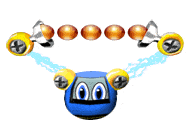- Wondering how to get Monopoly GO! free rolls? Well, you’ve come to the right place. In this guide, we provide you with a bunch of tips and tricks to get some free rolls for the hit new mobile game. We’ll …
Best Roblox Horror Games to Play Right Now – Updated Weekly
By Adele Wilson
Our Best Roblox Horror Games guide features the scariest and most creative experiences to play right now on the platform!The BEST Roblox Games of The Week – Games You Need To Play!
By Sho Roberts
Our feature shares our pick for the Best Roblox Games of the week! With our feature, we guarantee you'll find something new to play!Type Soul Clan Rarity Guide – All Legendary And Common Clans Listed!
By Nathan Ball
Wondering what your odds of rolling a particular Clan are? Wonder no more, with my handy Type Soul Clan Rarity guide.
Time Breaker Review
In the early 80s, game companies had mega-hits with brick-breaking games such as Arkanoid and Breakout. You know the premise: gamers are in control of a small paddle that moves left and right along the bottom of the screen. The goal is to prevent a ball from hitting the floor. When the ball bounces off the paddle, it breaks colored bricks at the top of the screen. The level is completed when all the bricks are gone. Players can also catch falling power-ups such as one that turns the ball into three.

In the early 80s, game companies had mega-hits with brick-breaking games such as Arkanoid and Breakout. You know the premise: gamers are in control of a small paddle that moves left and right along the bottom of the screen. The goal is to prevent a ball from hitting the floor. When the ball bounces off the paddle, it breaks colored bricks at the top of the screen. The level is completed when all the bricks are gone. Players can also catch falling power-ups such as one that turns the ball into three.
As it turns out, the 21st century has done nothing to dampen the brick-breaking spirits of the average game player – even while it’s raised the standards for creativity among game developers. Each incarnation of the genre tries to add a slightly different “spin” on the formula, and Time Breaker from Alawar is no exception.
In this case, Time Breaker introduces beautiful 3-D graphics. So, instead of a flat and lifeless wall of colored bricks, each level contains hissing serpents, a spinning helicopter or a dancing Pharaoh – all rendered in three dimensions and smoothly animated.
Time Breaker also features a number of unique power-ups to enhance the game-play. One such falling bonus gives you a droid paddle that will automatically move around the bottom of the screen to catch any balls you may miss. Another one puts a gravitational pull on your ball so you can slightly control its direction by holding down the left-mouse button. Another one lets you fire missiles at bricks.
In total, the game features 26 bonus power-ups. At the start of each level is a fact that is related to the shape of the bricks. For instance, before playing the level with a animated 3-D Ferris wheel, a pop-up window tells you the first Ferris wheel could carry 2160 people. Similarly, before playing the level with a sharp-toothed angler fish, you’re advised these creatures live more than a mile deep in the ocean. You get the idea.
Divided into easy, normal and difficult settings, Time Breaker houses 150 levels, spread across five main themes. All levels are locked until the previous screen is completed. At any time you can go back and play a favorite level.
Ironically, while the graphics are gorgeous, about a quarter of the screen is used to give gamers information such as score, level number, lives left and info on the last power-up collected. This lies along the right-hand side of the screen. Even on a large screen, this information panel is distracting and far too large; the developer should have given players the option to turn this on and off.
The upbeat and catchy music, on the other hand, is very well done. This is refreshing for a casual game, where music tends to be an afterthought more often than not. Sure, it’s a simple soundtrack, but it doesn’t sound like elevator muzak either.
Overall, Time Breaker is a stellar remake of the ‘ol Breakout games from yesteryear — but with modern graphics and clever power-ups that each put a fresh coat of paint on the tried-and-true game-play.

The good

The bad
More articles...
Monopoly GO! Free Rolls – Links For Free Dice
By Glen Fox
Wondering how to get Monopoly GO! free rolls? Well, you’ve come to the right place. In this guide, we provide you with a bunch of tips and tricks to get some free rolls for the hit new mobile game. We’ll …Best Roblox Horror Games to Play Right Now – Updated Weekly
By Adele Wilson
Our Best Roblox Horror Games guide features the scariest and most creative experiences to play right now on the platform!The BEST Roblox Games of The Week – Games You Need To Play!
By Sho Roberts
Our feature shares our pick for the Best Roblox Games of the week! With our feature, we guarantee you'll find something new to play!Type Soul Clan Rarity Guide – All Legendary And Common Clans Listed!
By Nathan Ball
Wondering what your odds of rolling a particular Clan are? Wonder no more, with my handy Type Soul Clan Rarity guide.







